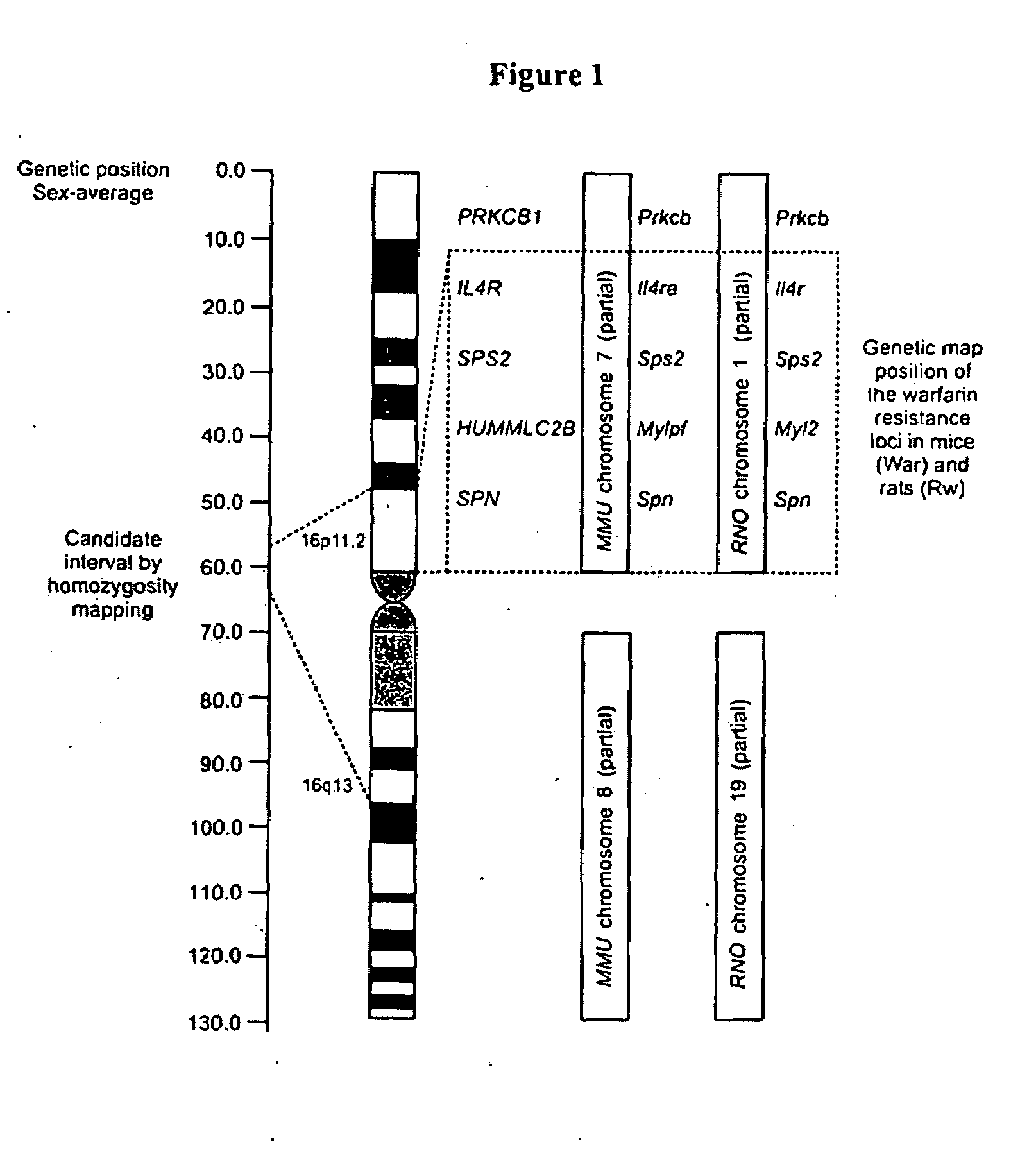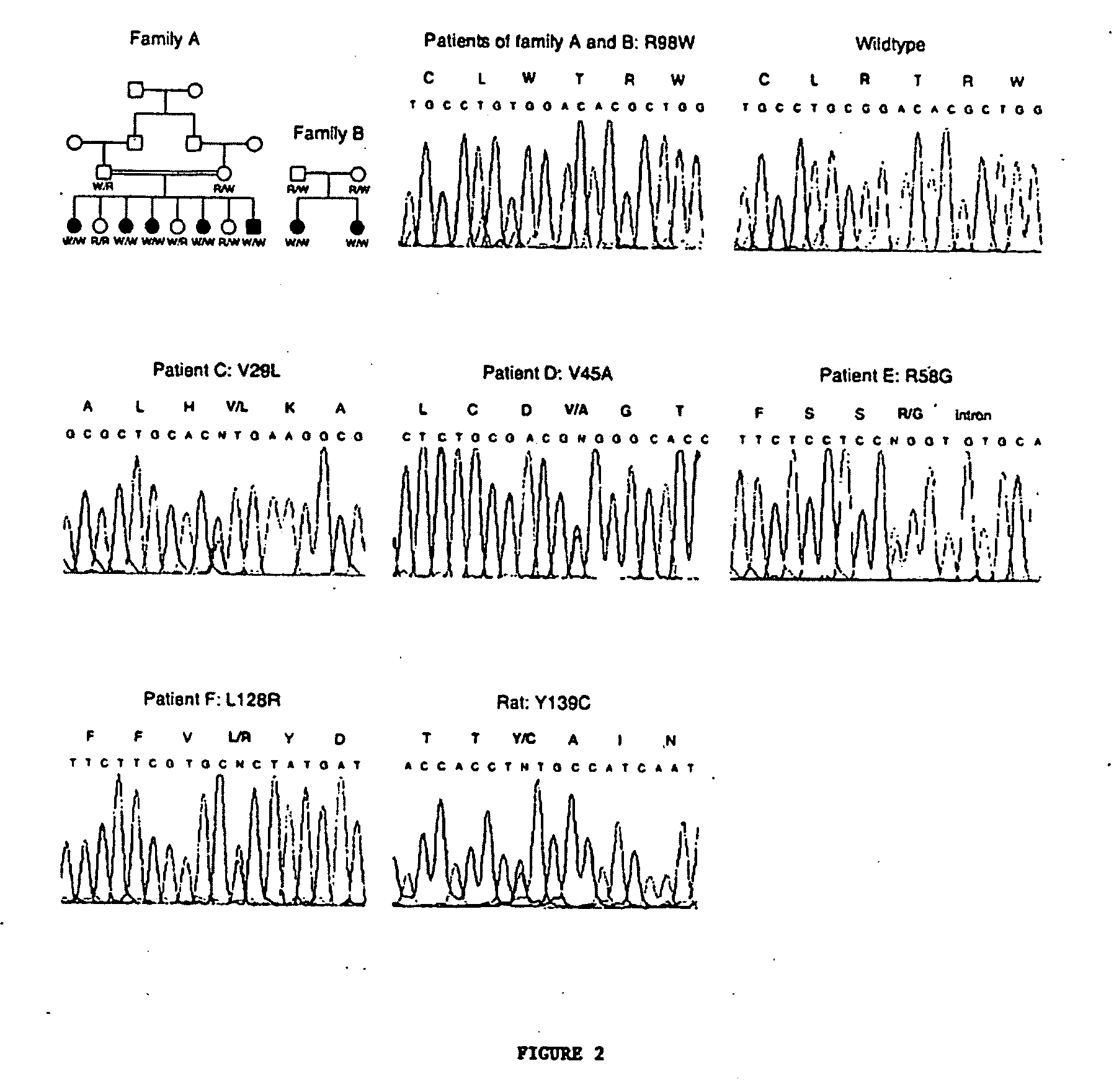Vitamin K Epoxide Recycling Polypeptide VKORC1, a Therapeutic Target of Coumarin and Their Derivatives
a technology of coumarin and vkorc1, which is applied in the field of new polypeptide vitamin k epoxide recycling polypeptide, can solve the problems of coumarin activity and the molecules interacting with coumarins that are still elusive, and the risk of spontaneous bleeding is high
- Summary
- Abstract
- Description
- Claims
- Application Information
AI Technical Summary
Benefits of technology
Problems solved by technology
Method used
Image
Examples
example 1
Characterization of the Genomic Candidate Region
[0205]The locus for combined deficiency of vitamin K-dependent clotting factor type 2 (VKCFD2) to the pericentromeric region of chromosome 16 between the markers D16S3131 and D16S419 has been mapped [Fregin et al., 2002]. This region comprises approximately 20 Mb. The genes responsible for warfarin resistance in rats (Rw) and mice (War) had been mapped to chromosome 1 [Kohn et al., 1999] and chromosome 7 [Wallace, 1976] [Greavses & Ayres, 1967] in close linkage to the myosin light chain 2 gene (Myl2). The human ortholog of Myl2, HUMMLC2B, is located on chromosome 16p11 within the VKCFD2 candidate region and is part of a conserved linkage group of genes. Based on this synteny and on biochemical considerations, it is hypothesized that VKCFD2 and warfarin resistance may be due to allelic mutations in the same gene. If so, this would narrow down the critical interval in humans to a region of approximately 4.5 Mb between the interleukin 4 r...
example 2
Mutation Screening
[0207]Using genomic DNA from two VKCFD2 and three WR subjects, a systematic mutation screen was initiated by comparative sequencing of the remaining candidate genes. Clinical data of the VKCFD2 families have been described previously [Oldenburg et al., 2000]. Warfarin resistant patients were ascertained due to their abnormal response to oral warfarin administration during thrombosis treatment or prevention. Patient C and E are sporadic cases. Patient D has two brothers also suffering from warfarin resistance. Patients C and D required approximately 150-250 mg warfarin per week to achieve a therapeutic range of oral anticoagulation whereas patient E did not show any response at all. All patients gave informed consent before participating.
[0208]Surprisingly, missense mutations were found in a gene of unknown function in all investigated VKCFD2 and WR subjects (FIG. 2). This gene (IMAGE3455200) spans a genomic region of 5126 bp and comprises three exons coding for a p...
example 3
Homology and Protein Structure
[0210]An orthologue of the VKORC1 gene was present in mouse (NM—178600) and the orthologues in rat and in Fugu rubripes were established by homology searches and RT-PCR (FIG. 3). The corresponding proteins share 79% to 84% identity with the human protein. Database searches did not show any homology to a known gene nor to any characterized protein domain. Topology prediction programs anticipated three transmembrane domains (TM). The first TM is placed between residues 10 to 29 by all programs tested. The predictions are discordant for the second and the third TM, which are located between amino acids 100 and 150. The PSORT II server predicted an ER membrane retention signal (KKXX or KXKXX) at position 159-163 of human VKORC1 with a probability of 67%[Jackson et al., 1990]. The consensus sequence was also present in the other VKORC1 proteins. This is in accordance with the likely location of the VKORC1 complex within the ER membrane system [Cain et al., 1...
PUM
| Property | Measurement | Unit |
|---|---|---|
| nucleic acid | aaaaa | aaaaa |
| resistance | aaaaa | aaaaa |
| warfarin resistance | aaaaa | aaaaa |
Abstract
Description
Claims
Application Information
 Login to View More
Login to View More - R&D
- Intellectual Property
- Life Sciences
- Materials
- Tech Scout
- Unparalleled Data Quality
- Higher Quality Content
- 60% Fewer Hallucinations
Browse by: Latest US Patents, China's latest patents, Technical Efficacy Thesaurus, Application Domain, Technology Topic, Popular Technical Reports.
© 2025 PatSnap. All rights reserved.Legal|Privacy policy|Modern Slavery Act Transparency Statement|Sitemap|About US| Contact US: help@patsnap.com



